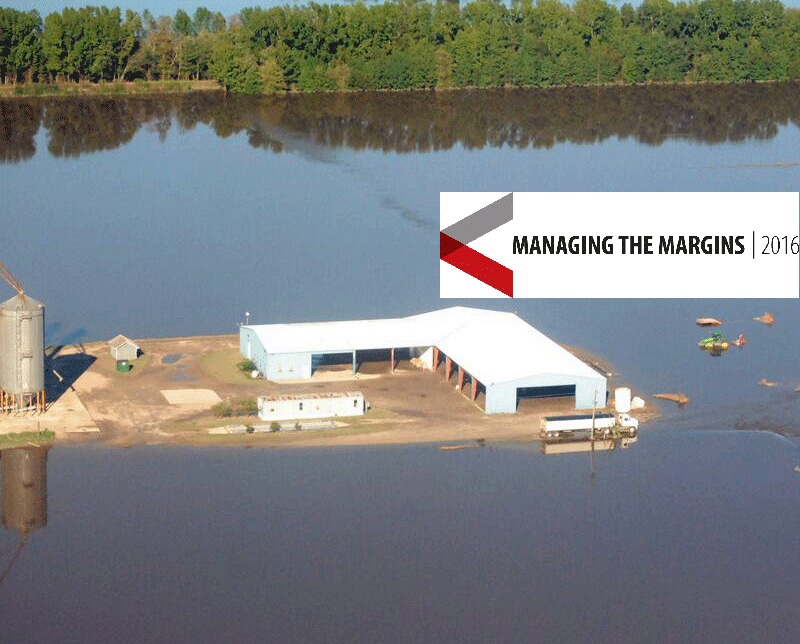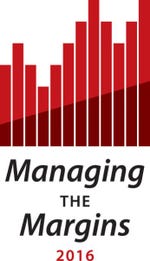
With margins tight and working capital a concern in 2016, it is a good idea to make sure your coverage is adequate for your situation and risks you face.In the Southeast where basis tends to be stronger than the Midwest, the insurance reference price might fall short of your expected local price.
February 10, 2016

One of the biggest risks in farming besides price is production risk. Crop insurance pays most often on drought in the Southeast. But South Carolina’s epic flood at harvest in 2015 resulted in catastrophic losses for the majority of row crop farmers in the state. Crop insurance is not designed to make you whole and some lessons were learned in South Carolina.
South Carolina experienced a 1,000-year rainfall event, which means meteorologists give it a 0.1 percent chance of occurring in any given year. The timing of the rains and flood waters was the worst possible as cotton, peanuts and soybeans were ready for or nearing harvest. A season’s worth of work was sitting in the field and was either ruined by the rain and flood or deteriorated because the ground never dried out enough to get equipment in the field. The majority of acres were insured in South Carolina at some level of crop insurance, mostly between 65 percent and 75 percent coverage.

“Managing the Margins: 2016” is a Southeast Farm Press series providing information and strategies to manage the financial risks associated with farming in the Southeast. Click logo to see more articles.
“Managing the Margins: 2016” is a Southeast Farm Press series providing information and strategies to manage the financial risks associated with farming in the Southeast. Click logo to see more articles.Even with crop insurance, a catastrophic disaster can undo what has been built up over 10 years. Look at the gaps in your insurance coverage. Can you handle the deductible in a catastrophic event like the 2015 floods where everything was practically a total loss?
The insurance reference price may or may not reflect the price you receive? In the Southeast where basis tends to be stronger than the Midwest, the insurance reference price might fall short of your expected local price.
The ARC-County program can help with shallow losses but is limited by the 10-percent cap on the county benchmark revenue and will not be available if triggered until October of the next year.
You can make an average yield but still have a near-total loss due to damage or quality losses. Quality adjustments are handled differently in policies for different crops.
More runner type peanuts were grown in South Carolina in 2015, and when switching types, the actual production history starts new for the different type being grown. So, be aware of lower guarantees due to a lack of yield history when switching crops or switching to a new enterprise for the farm.
Reluctant to 'zero out' a field if there is potential
If the crop is still standing and determined to have potential to be harvested, i.e. still has production to count, the farmer will have to wait until after the final harvest date to settle claims. The alternative is to go ahead and accept the adjuster’s yield assessment. This leads to the decision of is it worth trying to harvest or accepting production to count. Crop insurance companies are reluctant to “zero out” a field if there is potential to harvest.
When a field is zeroed out, the crop must be destroyed for the indemnity payment. In a flood or excessive rain situation, destroying the crop may not be possible due to conditions which can delay settling of claims. In several cases, the quality was so bad the crop wasn’t marketable.
Since the Actual Production History yield is a moving average between four and 10 years, it may drag behind expected yields as technology advances improve yields. Check with your crop insurance agent to see if you are eligible for trend adjusted yields in your county.
Catastrophic years can occur more than once in a 10-year period. The yield exclusion provision from the 2014 Farm Bill allows for an actual yield to be excluded if the county meets the eligibility requirements. Many counties across the Southeast meet the qualification for one or more crop years to exclude an actual yield for an eligible crop.
February 28 is the signup deadline for many spring planted crops in the Southeast. With margins tight and working capital a concern in 2016, it is a good idea to make sure your coverage is adequate for your situation and risks you face.
Ask your insurance agent about the potential of whole farm revenue protection (WFRP) insurance in 2016. The pilot program is a combination of Adjusted Gross Revenue and Adjusted Gross Revenue – Lite insurance programs prior to the 2014 Farm Bill. It insures the whole farm revenue at 50 percent to 85 percent coverage levels and can be purchased on top of buy-up yield or revenue coverage. It may provide broader level of revenue protection based on five years of tax returns, especially for diversified operations.
The WFRP insurance plan is tailored for any farm with up to $8.5 million in insured revenue, including farms with specialty or organic commodities (both crops and livestock), or those marketing to local, regional, farm-identity preserved, specialty or direct markets.
You May Also Like



